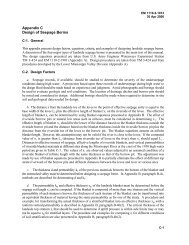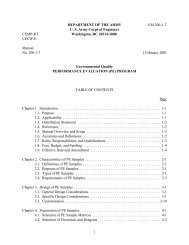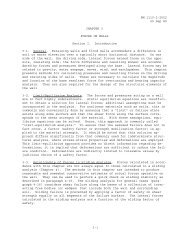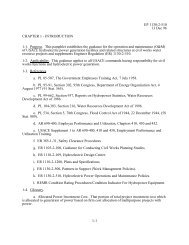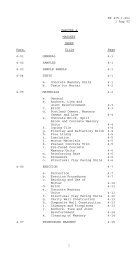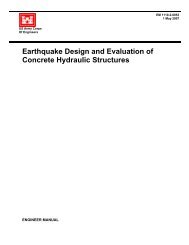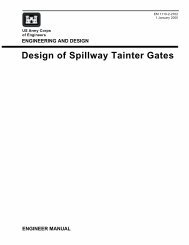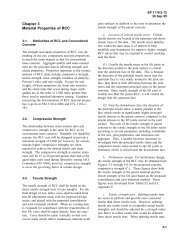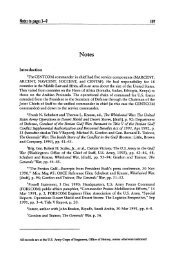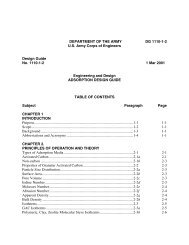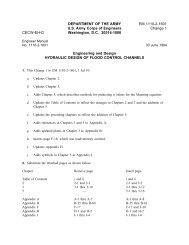Chapter 5 - Publications, US Army Corps of Engineers
Chapter 5 - Publications, US Army Corps of Engineers
Chapter 5 - Publications, US Army Corps of Engineers
You also want an ePaper? Increase the reach of your titles
YUMPU automatically turns print PDFs into web optimized ePapers that Google loves.
EM 1110-2-1701<br />
31 Dec 1985<br />
SSR is its complexity. Because <strong>of</strong> the large amount<br />
required to do daily studies for long time periods,<br />
routings are based on weekly or monthly intervals.<br />
<strong>of</strong> weekly or monthly average flows is satisfactory.<br />
<strong>of</strong> computer time<br />
most sequential<br />
Generally, the use<br />
Where using<br />
weekly or mnthly intervals results in an energy estimate that is<br />
substantially in error (see Section 5-6b(4)), SSR studies should be<br />
made using daily flows for all or part <strong>of</strong> the period <strong>of</strong> analysis.<br />
(3) The sequential streamflow routing method is described in<br />
Sections 5-8 through 5-14.<br />
d. flvbrid~ The hybrid method combines features <strong>of</strong> bth<br />
the duration curve and SSR methods. Historical streamflow and<br />
reservoir elevation data for the period <strong>of</strong> record are obtained either<br />
from historical records or from an existing SSR analysis (such as an<br />
operational study performed for evaluating existing project<br />
functions). Power output is computed sequentially for each interval<br />
in the period <strong>of</strong> record, and the resulting data is compiled into<br />
duration curve format for further evaluation. The hybrid method was<br />
developed primarily to investigate the addition <strong>of</strong> power at existing<br />
projects where head varies independently <strong>of</strong> flow. This includes flood<br />
control storage projects and projects with conservation storage<br />
regulated for non-power purposes. The hybrid method is usually faster<br />
than an SSR routing but slower than the flow-duration curve method.<br />
The hybrid method is described in Section 5-15.<br />
(1) ~ For very preliminary or screening studies, the<br />
flow-duration method can be used for almost any project, although<br />
energy estimates for projects with storage or where head varies<br />
independently <strong>of</strong> flow must be viewed with caution. Following is a<br />
discussion <strong>of</strong> the methods that would normally be used for the various<br />
types <strong>of</strong> projects.<br />
(2) aun-<strong>of</strong>-mer Pro~ For the typical run-<strong>of</strong>-river<br />
project, where head is essentially fixed (high head projects) or where<br />
head varies with discharge (low head projects), the flow-duration<br />
method is generally the best choice. Where head varies independently<br />
<strong>of</strong> flow, the hybrid method should be used. SSR can also be used, but<br />
is usually not selected for single projects because the daily flow<br />
analysis required to get accurate results for run-<strong>of</strong>-river projects is<br />
usually too time consuming. However, it is <strong>of</strong>ten desirable to use SSR<br />
to analyze run-<strong>of</strong>-river projects that are operated as a part <strong>of</strong> a<br />
system which also includes storage projects. An alternative to the<br />
latter would be to use streamflows from an existing system SSR study<br />
as input for a flow-duration or hybrid analysis.<br />
5-8




